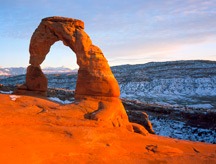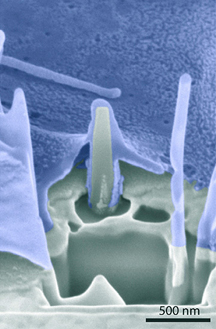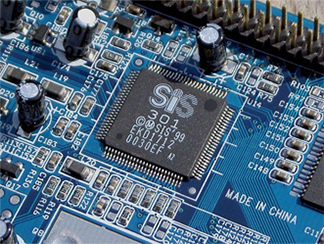


- MAKE YOUR OWN EXHIBIT
- WATCH A VIDEO
- READ A BLOG
- TACTILE & BRAILLE HTE
- AMERICAN SPACES
- PIN SOME IMAGES
- SHARE WITH A FRIEND

Topics: the pillars of erosion.
More about Pillars of Erosion

The relentless action of winds slowly carve away at the environment, leaving behind sculptures from erosion. Microchip fabrication uses particle beams to erode material and create structures on the surface.
Prolonged wind erosion in deserts leaves behind columns of dense rock. Winds from bright stars blow away their surroundings to unveil dense regions of gas from which stars are forming.
Watch a video on the Pillars of Erosion.
More Info.
Erosion is the process of wearing down an object by various forces. When the erosion is non-uniform, it can create spectacular structures such as the ones shown here.
Erosion occurs here, there and everywhere in nature. It is usually a two-step process: first some force such as rain breaks an object up, and then this same force, or another one, often combined with gravity, carries material away.
We can see the process of erosion all around us in small pillars of dust left behind after a rainstorm, in the fanciful shapes left in a melting snowbank, in the smooth shape of a mound of dirt that is gradually spreading out, or in ditches carved in soft ground after a rainstorm.
On a larger scale, the effects of wind, rain and gravity combine to form the spectacular buttes and spires in southwestern deserts of the United States. Erosion also takes place on a cosmic scale in interstellar space, where intense ultraviolet and X-radiation from bright stars can sculpt shapes of light years in size from dense clouds of gas and dust.
Erosion also occurs on very small scales. Scientists and engineers use beams of energetic particles in a controlled erosion process to create microscopic structures for smart phones, and other nano-technology devices.
Fun facts about erosion.
- Nano-pillars which are less about 100 nanometers tall and less than 10 nanometers (0.00000001 meters, or 0.00000039 inches) in diameter can now be fabricated for use in investigating the structure of living cells.
http://news.stanford.edu/news/2011/april/images/pillars_blue_news.jpg
http://news.stanford.edu/news/2011/april/nanopillars-molecular-photography-040611.html - The rock pillars in Pinnacles National Park in Australia are almost a billion times larger than the nano-pillars on microchips. They are thought to have been formed by erosion as water washed away the material not protected by erosion-resistant cap rocks.
http://www.westernaustralia-travellersguide.com/image-files/pinnacles-desert-western-australia.jpg - The Grand Canyon is one of the most spectacular examples of erosion on Earth. Over a period of six million years, the Colorado River has carved a canyon that is 277 river miles long, up to 18 miles wide and 6000 feet deep.
http://farm6.staticflickr.com/5100/5476545063_619f7eece4_o.jpg - Erosion on a cosmic scale formed the "Pillars of Creation" in the Eagle Nebula and similar structures in the Carina Nebula. Ultraviolet radiation and winds from nearby stars blew away gas from interstellar clouds, leaving behind dense columns of gas and dust light years long.
http://chandra.si.edu/photo/2007/m16/
http://www.spacetelescope.org/images/heic1007e/
Related Resources
Back to the Topics page

"Here, There, & Everywhere" (HTE) is supported by the National Aeronautics and Space Administration under grant NNX11AH28G issued through the Science Mission Directorate.
HTE was developed by the Chandra X-ray Center, at the Smithsonian Astrophysical Observatory, in Cambridge, MA.
Email: cxcpub@cfa.harvard.edu | Phone: 617.496.7941
Follow us: #HTEScience on Twitter



